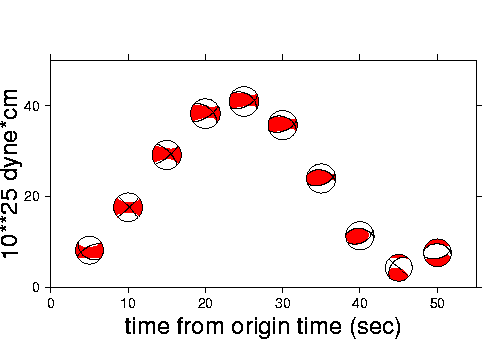
We determined the temporal distribution of moment release for September 5, 2004 Off Tokaido earthquake (origin time: 14:57:18 UTC; location: 33.15N 137.04E; depth: 10km; Mw: 7.4 after USGS) following Hara (2004a). In his technique, long period body wave data in the period range of 50-100 sec are used to invert for temporal distribution of moment release. The centroid is placed at 32.92N, 136.77E (Hara, 2004b).
Figure 1 shows the result. For the first 20 sec during the rupture, the strike slip component can be seen, while the reverse fault is predominant during 25-40 sec. The temporal resolution in this analysis is about 20 sec (Å}10 sec), and it is possible to detect the change of source mechanism such as shown in Fig. 1. It is interesting to note the consistency between the strike slip component obtained in this analysis and the source mechanisms of aftershocks that occurred in the northern part of the main shock (http://www.jishin.go.jp/main/chousa/04sep_kiihantou2/p04.jpg).
Our result implies that this earthquake is the compound event consisting of (at least) two different source mechanisms.

Figure 1. Temporal distribution of moment release for September 5, 2004 Off Tokaido earthquake. The vertical axis shows the scalar moments of subevents.